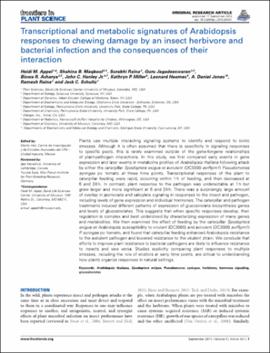| dc.contributor.author | Appel, Heidi M. | |
| dc.contributor.author | Maqbool, Shahina B. | |
| dc.contributor.author | Raina, Surabhi | |
| dc.contributor.author | Jagadeeswaran, Guru | |
| dc.contributor.author | Acharya, Biswa R. | |
| dc.contributor.author | Hanley, John C. | |
| dc.contributor.author | Miller, Kathryn P. | |
| dc.contributor.author | Hearnes, Leonard | |
| dc.contributor.author | Jones, A. Daniel | |
| dc.contributor.author | Raina, Ramesh | |
| dc.contributor.author | Schultz, Jack C. | |
| dc.date.accessioned | 2019-09-25T18:24:47Z | |
| dc.date.available | 2019-09-25T18:24:47Z | |
| dc.date.issued | 2014-09-17 | |
| dc.identifier | oksd_appel_transcriptional_2014 | |
| dc.identifier.citation | Appel, H. M., Maqbool, S. B., Raina, S., Jagadeeswaran, G., Acharya, B. R., Hanley, J. C., Miller, K. P., Hearnes, L., Jones, A. D., Raina, R., & Schultz, J. C. (2014). Transcriptional and metabolic signatures of Arabidopsis responses to chewing damage by an insect herbivore and bacterial infection and the consequences of their interaction. Frontiers in Plant Science, 5. https://doi.org/10.3389/fpls.2014.00441 | |
| dc.identifier.uri | https://hdl.handle.net/11244/321452 | |
| dc.description.abstract | Plants use multiple interacting signaling systems to identify and respond to biotic stresses. Although it is often assumed that there is specificity in signaling responses to specific pests, this is rarely examined outside of the gene-for-gene relationships of plant-pathogen interactions. In this study, we first compared early events in gene expression and later events in metabolite profiles of Arabidopsis thaliana following attack by either the caterpillar Spodoptera exigua or avirulent (DC3000 avrRpm1) Pseudomonas syringae pv. tomato at three time points. Transcriptional responses of the plant to caterpillar feeding were rapid, occurring within 1 h of feeding, and then decreased at 6 and 24 h. In contrast, plant response to the pathogen was undetectable at 1 h but grew larger and more significant at 6 and 24 h. There was a surprisingly large amount of overlap in jasmonate and salicylate signaling in responses to the insect and pathogen, including levels of gene expression and individual hormones. The caterpillar and pathogen treatments induced different patterns of expression of glucosinolate biosynthesis genes and levels of glucosinolates. This suggests that when specific responses develop, their regulation is complex and best understood by characterizing expression of many genes and metabolites. We then examined the effect of feeding by the caterpillar Spodoptera exigua on Arabidopsis susceptibility to virulent (DC3000) and avirulent (DC3000 avrRpm1) P. syringae pv. tomato, and found that caterpillar feeding enhanced Arabidopsis resistance to the avirulent pathogen and lowered resistance to the virulent strain. We conclude that efforts to improve plant resistance to bacterial pathogens are likely to influence resistance to insects and vice versa. Studies explicitly comparing plant responses to multiple stresses, including the role of elicitors at early time points, are critical to understanding how plants organize responses in natural settings. | |
| dc.format | application/pdf | |
| dc.language | en_US | |
| dc.publisher | Frontiers Media | |
| dc.rights | This material has been previously published. In the Oklahoma State University Library's institutional repository this version is made available through the open access principles and the terms of agreement/consent between the author(s) and the publisher. The permission policy on the use, reproduction or distribution of the material falls under fair use for educational, scholarship, and research purposes. Contact Digital Resources and Discovery Services at lib-dls@okstate.edu or 405-744-9161 for further information. | |
| dc.title | Transcriptional and metabolic signatures of Arabidopsis responses to chewing damage by an insect herbivore and bacterial infection and the consequences of their interaction | |
| osu.filename | oksd_appel_transcriptional_2014.pdf | |
| dc.description.peerreview | Peer reviewed | |
| dc.identifier.doi | 10.3389/fpls.2014.00441 | |
| dc.description.department | Biochemistry and Molecular Biology | |
| dc.type.genre | Article | |
| dc.type.material | Text | |
| dc.subject.keywords | glucosinolates | |
| dc.subject.keywords | arabidopsis thaliana | |
| dc.subject.keywords | spodoptera exigua | |
| dc.subject.keywords | pseudomonas syringae | |
| dc.subject.keywords | herbivory | |
| dc.subject.keywords | hormone signaling | |
